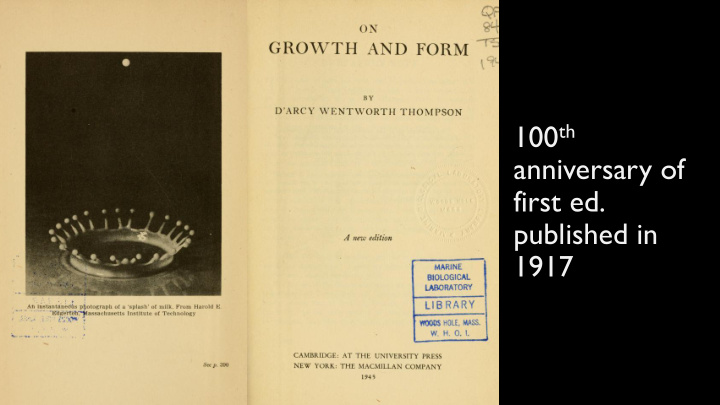



100 th anniversary of first ed. published in 1917
• About physical laws and forces governing biological form • Pioneered the use of math in biology • First ed. in 1917, second in 1942 (won an award from the US National Academy of Sciences) • Very influential (cited over 7000 times, reprinted over forty times since first ed.); influenced: biologists, mathematicians, architects, engineers, artists • Praised for being well written • Criticized for lack of recognition of evolutionary forces • Overall: a classic, a pioneering work
D’Arcy Wentworth Thompson • 1860-1948 • Scottish • Professor of Natural History at University College, Dundee for 32 years, then St Andrews for 31 years • Created Zoology Museum for teaching a research, Uni. of Dundee • Published around 300 articles and books, most important being: • “On growth and form” Dundee • Translation from Greek of Aristotle’s “History of animals” • Glossaries of Greek birds and fishes • Received many honors and awards, knighted • Extracurricular activities (e.g., served on committee of management of Dundee Private Hospital for Women)
Chapter 15: On the shape of eggs and other hollow structures Harvard Museum of Comparative Zoology
Chapter 9: On concretions, spicules, and specular www.spongeguide.org Van Soest RWM et al 2012 PLoS ONE
Chapter 11: The logarithmic spiral Morn the Gorn, www.Wikipedia.org Luiz Real, commons.Wikimedia.org
FORCES Concept word: • Physical forces that determine biological form • They are invisible but we can infer about them from observation of forms • Can be described using mathematical language Why? • Because they are real • And affect EVERYTHING inside us and around us • Allow us to better understand the world we live in • Without this understanding, we would still live in caves
Spare slides
Spur-winged lapwing Common murre www.indianexpress.com Quail, ostrich, chicken
Chris 73, Wikipedia.org
Chapter 17: On the Theory of Transformations, or the Comparison of Related Forms Thompson illustrated the transformation of Argyropelecus olfersi into Sternoptyx diaphana by applying a shear mapping. Durer, www.wikipedia.org www.wikipedia.org
Radiolaria sceletons (one-cell organisms) drawn by Ernst Haeckel, 1904
• www.knowyourmeme.com
Recommend
More recommend